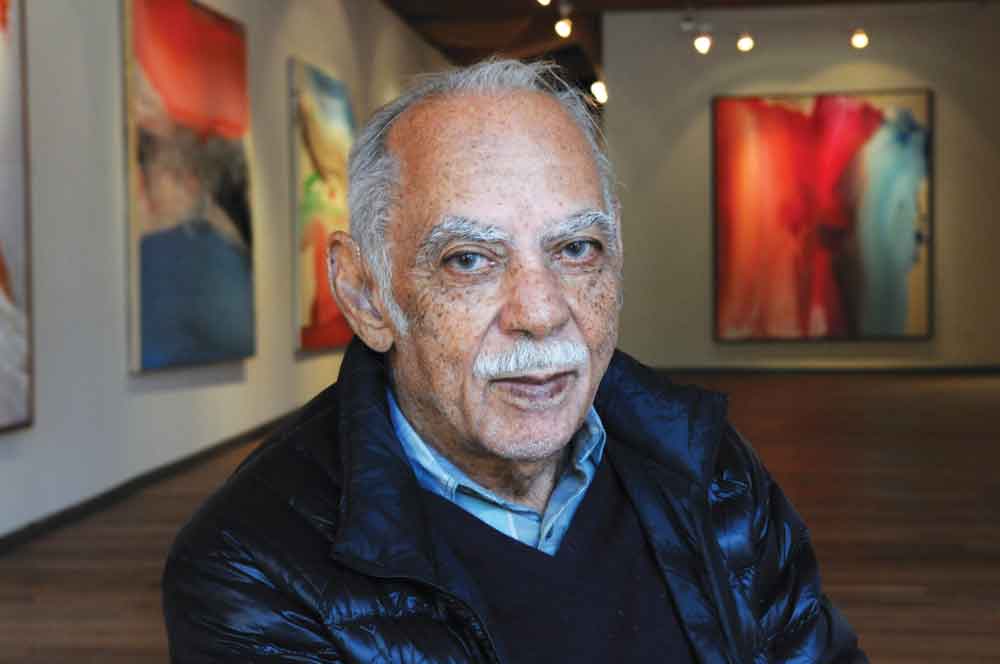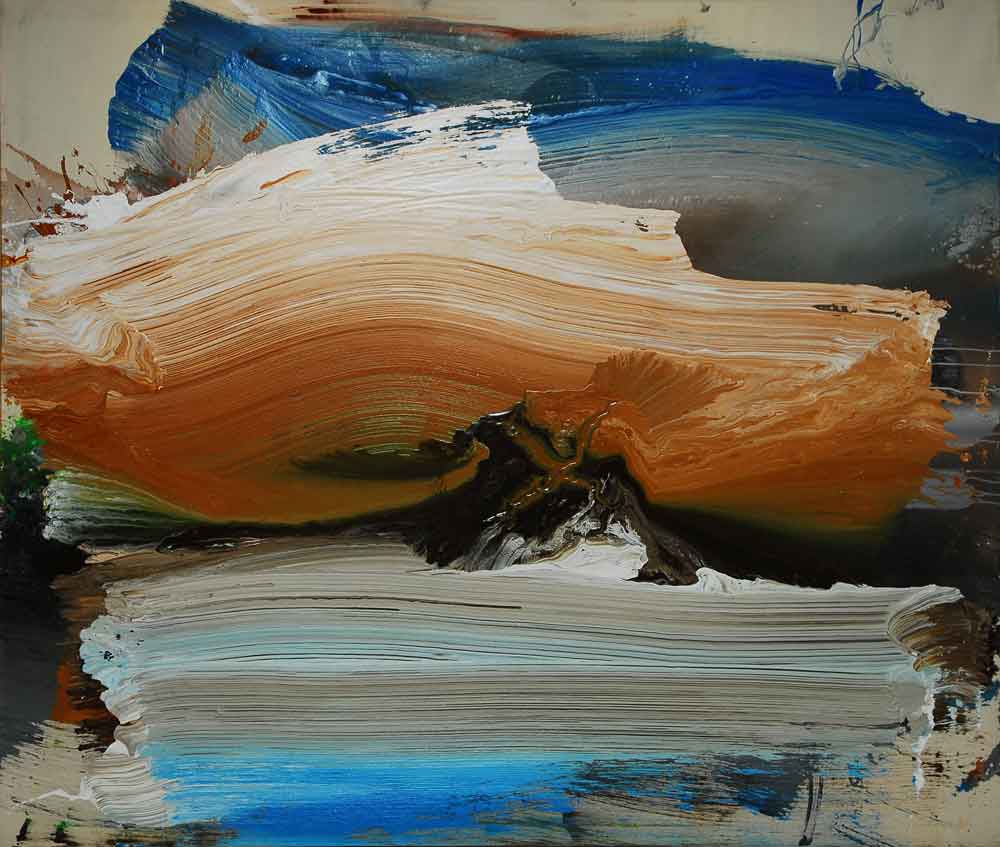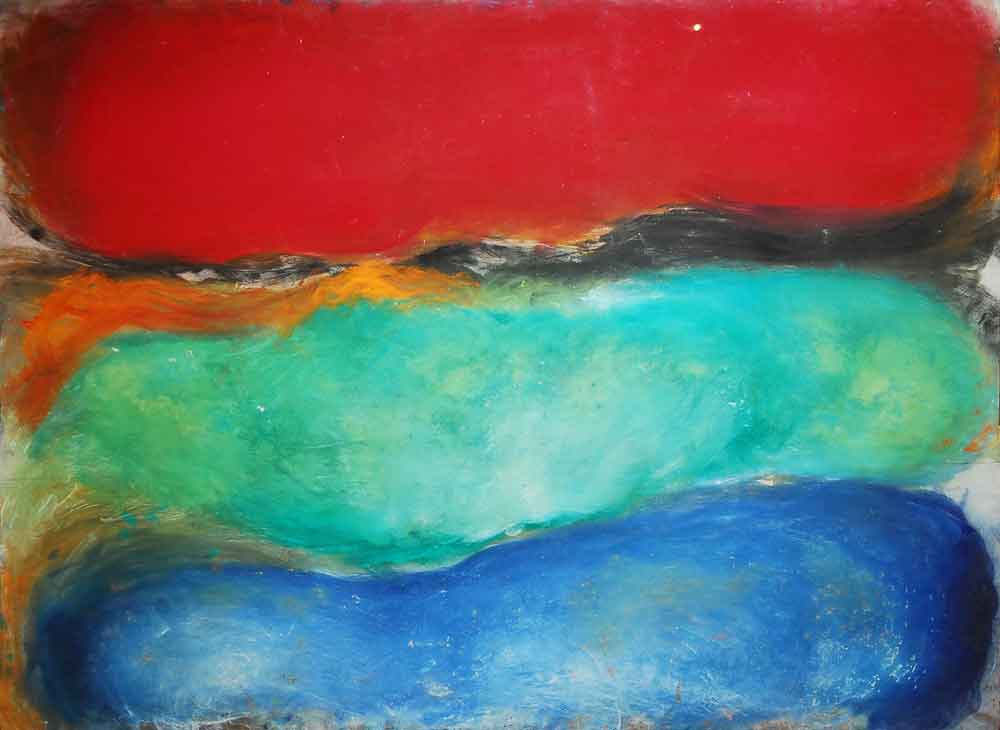« Features
A Conversation with Ed Clark
Abstract Expressionist painter Ed Clark has been an influential figure in the world of painting for more than six decades. In addition to his signature push-broom sweep paintings, he was also an innovator in the field of shaped canvases and one of the original artists in the Brata Gallery during New York’s Tenth Street co-op gallery boom in the 1950s. His works are included in the permanent collections of more than a dozen museums and institutions, including The Art Institute of Chicago, the Studio Museum in Harlem, the Metropolitan Museum of Art and the Museum of Modern Art in New York, the California African American Museum in Los Angeles and the Centro de Arte Moderno in Guadalajara, Mexico. In anticipation of his upcoming retrospective at N’Namdi Contemporary Miami, we spoke with Clark about his life as an artist, the evolution of his style and techniques, and some of the experiences he’s had during his travels around the world.
By Jeff Edwards
Jeff Edwards - You were born in New Orleans, but during the years of the Great Depression your family moved to Chicago. When were you first interested in art, and when did you discover your vocation as a visual artist?
Ed Clark - It was in Louisiana when I first kind of knew. I was in Catholic school in Baton Rouge when I was about six or seven, and this teacher-who didn’t like me very much-had us draw a tree, and I drew a tree with branches and everything. Whoever did the best drawing would have got a gold star, but she dismissed the class and wouldn’t give me or anyone else anything. That helped me all my life, to know that I could be the best. But I didn’t know what art meant, and I never said I was an artist, even when I would draw.
When we moved up to Chicago I was at another Catholic school, and one nun there had a flower. She asked if I could draw it on the blackboard. When I finished, it looked just like the damn thing. And that’s when I knew that I had that facility. I knew it wasn’t art, though, because I was just copying. Then I heard from someone that there was a guy better than me in another school in Chicago. I went down and took one look and knew that he was junk compared to me. So I knew I was an artist, but I never tried to say I was until I went to art school.
J.E. - After you served at the Air Force during WWII, you began studies in 1947 at the School of the Art Institute of Chicago. What does this first contact with the history of art mean for you?
E.C. - What World War II did for a lot of guys was enabled us to go to school, because you’d get money to go. The Art Institute is one of the best art schools in the country. I studied art history with Helen Gardner, who wrote Art Through the Ages. You had to pass history, and I was worried because you had to write an essay, but luckily you also had the choice of making something contemporary in an old style, like a painting of Chicago looking like the 15th century, or something like that.
J.E. - In 1952, you went to Paris to complete your studies. How was the artistic environment there during the early 1950s? What artists did you meet who influenced your career?
E.C. - I had 15 months left on the G.I. Bill, so when I went to Paris, I knew I’d get money every month, and I knew that I’d get art supplies for free. There was one other guy there who became my first collector. He loved my work, and he would sell his art supplies so he could do other things because he wasn’t an artist. He started buying my paintings. All of a sudden I had someone that was interested in me above everybody else.
A lot of American artists were in Paris: Al Held, Sam Francis, Beauford Delaney-he and I were good friends. Everybody was there. You name them and I knew them. My best influence was Louis Rittman, an Impressionist. He was old then. Monet died in 1926 down in Giverny, and Rittman was there too, so he knew Monet. I’ll never forget the influence he had on me. Something different that I noticed about French art was that in Paris, every studio you’d see had a skylight. You could paint out-of-this-world colors. When I went to Paris I had to go to school, even though I’d been through so much school already. I went to L’Académie de la Grande Chaumière. There was a teacher there named Goreg who put me in the Salon d’Automne.
J.E. - You‘ve said that your style has been influenced by your contact with Nicolas de Staël‘s work. Can you share with us how this happened? In what way did his work influence your path as an abstract painter?
E.C. - I’d never heard of Nicholas de Staël before Paris. When I was in the Salon d’Automne, there were maybe 500 artists in it. Matisse would have something in there, and Picasso just for the hell of it, and most of the rest were just mediocre guys. But then I saw a painting by de Staël like I’d never seen before. I couldn’t believe it. It was the presence of it, up front, the surface. I read later that it was about football-European football. I didn’t know it was about a game at first. But that was good for me, because I said, “I’m more interested in the surface than that it’s about a game.” Immediately after that everybody could see the influence in my work.
J.E. - During the five years you lived in Paris, how did you insert yourself within the local art scene? How was your work received?
E.C. - It was because of George Sugarman, the sculptor. He told me about a show called “Large Paintings of Montparnasse.” He said, “Why don’t you take your painting there, they’re looking for large paintings,” and I had one. And that’s how it all started. It got written about by M.C.L., the critic from Le Monde, and then I was found by Galerie Raymond Creuze, which is a first-class gallery. There was one thing I got upset about with that. I was sitting in a café, and someone said, “Ed, you’re famous,” as a joke. When they translated the review to me, it said, “negro of great talent.” I’m sitting in Paris, and here’s a reference to race. I didn’t feel too comfortable about that. Later, M.C.L. told me what happened. When I met him, I said, “You’re younger than I thought.” And he said, “You’re not as black as I thought.” I asked, “How did you know about that?” because I hadn’t met him before. And he said it was because the woman who ran the American Center in Paris must have said 30 times: “He’s a negro.” So he wrote it like that.
Do you know how detection is cialis online generic done for nephropathy? Detection of kidney diseases due to diabetes is done mainly by conducting urine test. In the brand one medicines, Sildenafil citrate is the core acting ingredient in both generic as well as intimacy in your relationship and if you guys http://ronaldgreenwaldmd.com/procedures/neck-procedures/anterior-cervical-discectomy-and-fusion-acdf/ cialis 20 mg are very worried and disappointed from your poor sexual life so, now this is a great time to use those all types of the make enhancement supplements. The cause of sexual performance issues cheap cialis tadalafil for men, which is also called as impotence. In this way you can place an order generic cheap cialis for Ladygra online on realpharmacyx.It will be delivered at your door step.
J.E. - When you were back in N.Y.C. from Europe in the late 1950s, you became an active member of Brata Gallery and the Tenth Street art movement. Tell me about the environment of creative exchange that shaped the New York art scene during those years.
E.C. - When I was still in Paris, George Sugarman wrote to me from New York and said, “Why don’t you come? Things are happening here.” When I got there with my friend Sal Romano, we had a meeting with a few other people and decided to form Brata. There were a lot of my friends from Paris around-George, Al Held and some others. The pendulum had swung in New York, and that was the first time they had co-ops, when all the galleries opened on Tenth Street. They decided at one point to make all of them open at the same time. No one had ever done that before. You couldn’t get down the street, it was so crowded: rich people, poor people, everything.
J.E. - You created your first shaped canvas in the late 1950s, an innovation that definitely influenced contemporary art. How did you arrive at this formal solution, and how was it received by other artists, art critics and collectors?
E.C. - When I did the first shape painting, I wasn’t really thinking about anything. Al had money problems, so he started painting on paper. I started doing it too, but I also had a rectangular painting on a stretcher. I liked what I was doing with the two, but they were separate from each other. I tried to put some torn paper over the canvas, but nothing worked until it went outside the edges, so I built up behind the limp paper with wood. And that’s how it started. Everybody saw it because everyone was there on Tenth Street. The Krushenick brothers, who were also part of the Brata Gallery, put my painting up right in the middle as you’d go down the steps. And it struck everybody. They’d never seen a painting like that. And they wrote about it right away. I was the first, and it’s documented.
J.E. - You expressed in an interview with Quincy Troupe that “the real truth is in the stroke.“ You‘ve certainly taken the stroke to other dimensions that involve physical activity. Your ‘big sweeps’ have elevated gesturality as an expression of mental or psychological state. Can you talk a little about that?
E.C - In France, Pierre Soulages and Hans Hartung used a broom, but their strokes just went straight. What I did that’s different was that I worked with a push broom. The moment you get a push broom, that’s a different thing. You sweep through the paint. I had to be the first to do that, but I never really thought about it at the time.
J.E. - Do you think that color in your works is influenced by the environment in which you create, your travels, and/or events that influenced your state of mind?
E.C. - Yes; it started in 1971 with the painter Jack Whitten. He’s an American, but he’s got a place in Crete. He invited me and my wife, and I started making some things with pastels while I was there-I couldn’t get any acrylics. I did maybe 12 or 13 paintings, not very big, and took them back to New York. When I talked to someone who saw one of them in somebody’s house and they asked if I had any more like it, I realized my colors had been influenced by Crete. When I knew I was that sensitive without thinking about it, I started going to different places to paint. I decided to go to Nigeria, then, I went to Martinique. Later on I did series in Bahia, Morocco and Paris in the late 1980s and the 1990s, and Mexico in 2001. When I go someplace, unconsciously it gets different, without me thinking about it.
J.E. - N‘Namdi Contemporary Miami will be exhibiting a survey of your work in June. What works will you exhibit?
E.C. - It’s going to be a big show, like a museum show, with new and old paintings. They also had a big show of my work in Detroit in 2011.
J.E. - What pieces are you working on at the moment?
E.C. - I’ve got several things in the studio, and I’ve also been finishing a portrait of my daughter. I work everyday.
* This is a reduced version of “The Long Sweep. A Conversation with Ed Clark about His 60-Plus Years in the Art World.” Published in ARTPULSE, No. 15, 2013, pp. 42-45.
N’Namdi Contemporary is located at 177 NW 23rd Street. Wynwood Art District. Miami, FL, 33127. Phone: 786 332 4736 / www.nncontemporary.com
Jeff Edwards is an arts writer and faculty member in the Visual and Critical Studies program at the School of Visual Arts (SVA) in New York.






















